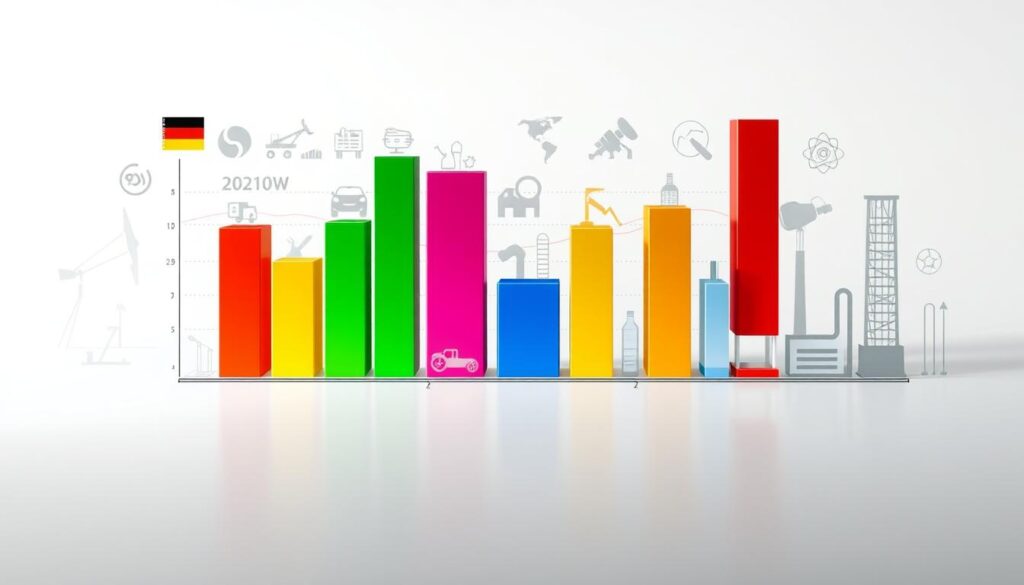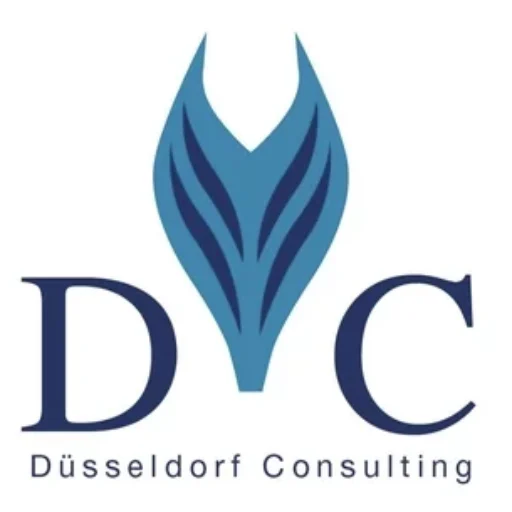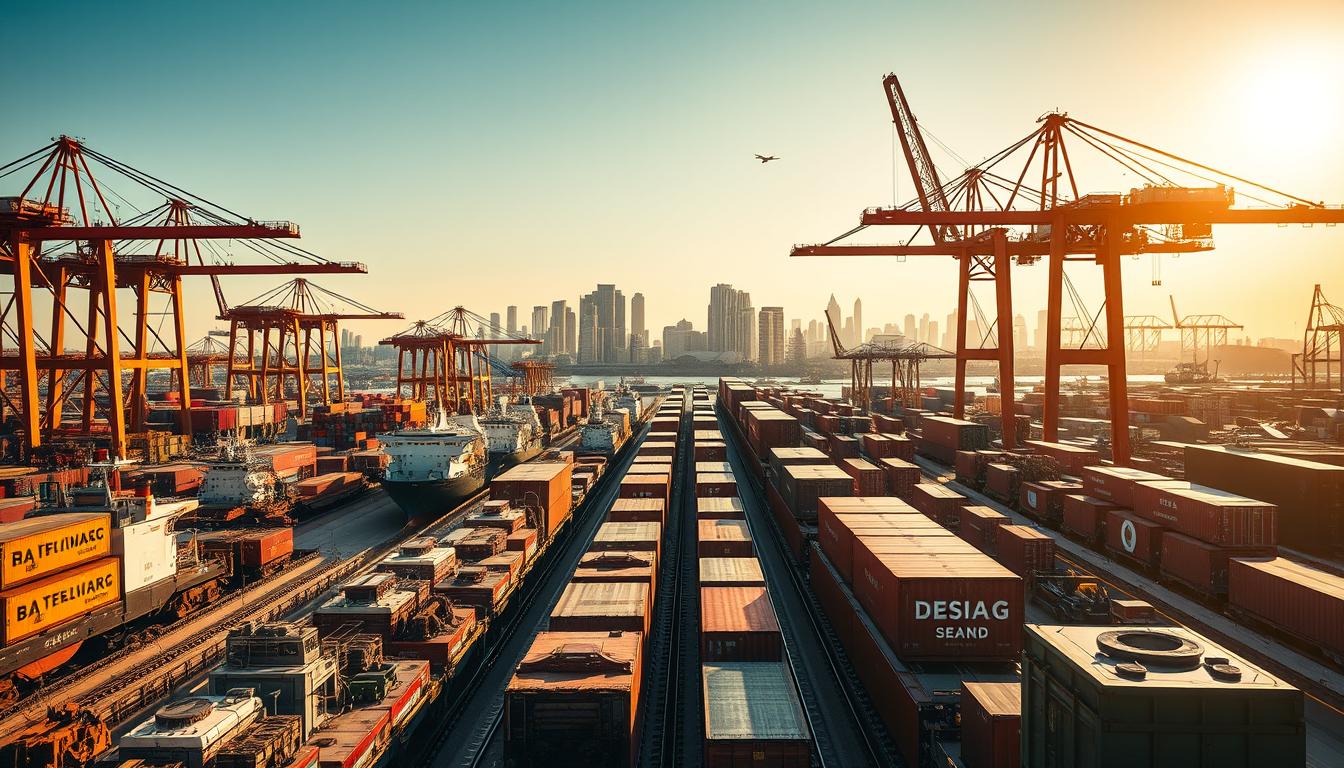Germany stands at the forefront of global trade, not just as a leading exporter but also as a significant importer. With a strong economy and a strategic location in the heart of Europe, Germany’s export sectors play a crucial role in the country’s economic dynamics.
Düsseldorf Consulting GmbH, a renowned consulting firm based in Düsseldorf, highlights the importance of understanding Germany’s export landscape. The country’s export sectors are diverse, ranging from machinery and automotive to chemicals and pharmaceuticals.
Key Takeaways
- Germany is a leading player in global trade.
- The country’s export sectors are diverse and dynamic.
- Key export categories include machinery, automotive, and chemicals.
- Germany’s strategic location facilitates trade with European partners.
- The country’s strong economy supports its export-oriented industry.
Introduction to Germany’s Economy
Germany’s economic landscape is characterized by a strong export-oriented manufacturing sector. As a global leader in international trade, the country’s economy thrives on its ability to export high-quality products worldwide. “ACTA NON VERBA” or “deeds not words” aptly describes Germany’s approach to economic success through tangible actions in the export industry.
The significance of exports to Germany’s GDP cannot be overstated. Exports play a crucial role in the country’s economic stability, with a substantial portion of its manufacturing output being shipped abroad. Key trade partners include other European countries, the United States, and increasingly, countries in Asia, particularly China. For instance, the automotive sector is a major contributor to Germany’s exports, with brands like Mercedes-Benz and BMW being globally recognized.
Analyzing Germany’s trade dynamics reveals a complex interplay between various sectors. The country’s robust manufacturing base and high-quality product standards are critical factors in its export success. Moreover, Germany’s strategic position in Europe, coupled with its well-developed infrastructure, facilitates trade with neighboring countries and beyond. For those interested in exploring other industries in Germany, such as the aerospace sector, opportunities and strategies for market entry provide valuable insights.
Germany’s export industry is supported by a network of small and medium-sized enterprises (SMEs) that are highly innovative and competitive. These businesses often specialize in niche areas, contributing to the diversity of Germany’s export portfolio. The country’s economic stability is thus closely tied to its ability to maintain a competitive edge in international markets.
Historical Context of German Exports
Germany’s export prowess has its roots in the post-war era, with significant milestones marking its journey to becoming the world’s third-largest exporter. In 2017, Germany’s total exports were valued at $1.33 trillion, a testament to its strong trade sectors.
The historical evolution of German trade sectors is closely tied to the country’s post-World War II economic recovery. The period saw significant investment in industrial infrastructure, laying the groundwork for future export growth.
A major factor in Germany’s export success has been its strategic trade policies. The country has consistently prioritized innovation and quality, making its products highly competitive in the global market.
Membership in the European Union (EU) has also played a crucial role in shaping Export data Germany. The EU’s single market policies have facilitated trade by reducing barriers and increasing access to other member states.
Key Milestones in German Export History
- Post-WWII economic recovery and industrial rebuilding
- Formation of the European Economic Community (EEC), precursor to the EU
- Adoption of the Euro currency, simplifying trade within the Eurozone
- Expansion of trade agreements with non-EU countries
Düsseldorf Consulting GmbH has been instrumental in analyzing and advising on Germany’s export strategies, highlighting the importance of SMEs in the export landscape.
| Year | Total Exports ($ trillion) | Major Export Sectors |
|---|---|---|
| 2015 | 1.23 | Automotive, Machinery, Chemicals |
| 2016 | 1.28 | Automotive, Machinery, Electronics |
| 2017 | 1.33 | Automotive, Chemicals, Machinery |
The data illustrates the steady growth of Germany’s exports, with key sectors including automotive, machinery, and chemicals. This historical context underscores the resilience and adaptability of German trade sectors.
Overview of Major Export Sectors
With a strong focus on quality and innovation, Germany’s major export sectors drive its economic success. Germany’s export market is characterized by its strong manufacturing and industrial goods sectors, with key industries including automotive, machinery, and chemicals.
Germany’s main exports include motor vehicles and parts, machinery, and chemicals, with key importing countries being the United States, China, and France. The automotive industry is a significant contributor, with German manufacturers renowned for their quality and engineering.

The machinery sector is another crucial component, providing advanced equipment for various industries worldwide. Germany’s chemical and pharmaceutical exports also play a vital role, with companies producing high-quality products that meet global demand.
According to Germany trade statistics, these sectors have consistently driven the country’s export growth, contributing to its position as a leading global exporter. An export market analysis of Germany reveals the importance of these industries in maintaining the country’s economic stability and competitiveness.
- Motor vehicles and parts
- Machinery
- Chemicals and pharmaceuticals
Addressing Königsallee 22, 40212 Düsseldorf, one can find detailed reports and analyses that further elucidate the dynamics of Germany’s export sectors. Understanding these dynamics is crucial for businesses looking to engage with or invest in the German economy.
The Role of the Automotive Industry
As the world’s largest exporter of cars, Germany’s automotive sector plays a pivotal role in its economic strength. The industry is dominated by renowned brands such as Mercedes-Benz, BMW, and Volkswagen, which are recognized globally for their quality and innovation.
The automotive industry’s contribution to Germany’s export economy is multifaceted. Not only does it generate significant revenue, but it also drives innovation, with a strong focus on sustainability and technological advancement. Electrification and autonomous driving are key areas where German automakers are leading the way, ensuring the industry remains competitive in a rapidly evolving global market.
Some of the key factors that contribute to the success of Germany’s automotive industry include:
- A highly skilled workforce
- Strong research and development capabilities
- A robust supply chain
- Innovative manufacturing technologies
Germany’s automotive exports are destined for various countries around the world, including the United States, the United Kingdom, and China. This global reach not only diversifies Germany’s export markets but also enhances its economic resilience.
ACTA NON VERBA – Actions, not words, is a mantra that reflects the industry’s commitment to tangible achievements in innovation and export performance. As the automotive landscape continues to evolve, Germany’s industry is poised to remain at the forefront, driven by its tradition of excellence and commitment to future technologies.
Analyzing the Chemical Sector
With its rich history and innovative spirit, Germany’s chemical industry stands out as a major player in global exports. The sector is a significant contributor to the country’s economy, producing a wide range of products including pharmaceuticals, plastics, and fertilizers. Companies like BASF and Bayer are leading the way, not only in Germany but also globally.
The chemical industry’s importance extends beyond its economic contribution. It plays a crucial role in providing essential products that impact various aspects of daily life and other industries. For instance, the production of specialty chemicals is vital for manufacturing processes in sectors such as automotive and construction.
Germany’s chemical exports are significant, with major destinations including the United States and China. The industry’s ability to innovate and adapt to changing regulatory environments has been key to its success. However, it faces challenges such as stringent environmental regulations and the need to comply with diverse international standards.
Key Statistics and Trends
| Product Category | Export Value (2022) | Major Export Destinations |
|---|---|---|
| Pharmaceuticals | $53 billion | USA, China, UK |
| Specialty Chemicals | $28 billion | France, Netherlands, Belgium |
| Basic Chemicals | $45 billion | China, USA, Italy |
The data highlights the diversity of Germany’s chemical exports and the significant role of the industry in the global market. As the industry continues to evolve, it is likely to remain a crucial component of Germany’s export economy.
Machinery and Equipment Exports
With a strong focus on innovation and quality, Germany’s machinery exports play a crucial role in the global supply chain. The country’s machinery sector is diverse, encompassing a wide range of products from heavy machinery to precision engineering tools.
Germany’s machinery exports are significant, with key markets including the United States, China, and France. According to recent trade statistics, the total export value of machinery from Germany was around $203 billion, underscoring the sector’s importance in Germany’s industrial base.
Leading Types of Machinery Exports
- Heavy machinery for construction and mining
- Precision engineering tools
- Automotive manufacturing equipment
- Agricultural machinery
The machinery and equipment sector is characterized by its high level of innovation. Companies in this sector invest heavily in research and development, driving advancements in manufacturing technologies. For instance, the integration of Industry 4.0 technologies, such as IoT and AI, has transformed production processes, making them more efficient and flexible.

To better understand the dynamics of Germany’s machinery exports, let’s examine the trade data in more detail. The table below provides an overview of Germany’s machinery exports to its top trading partners.
| Country | Export Value (in billion $) | Percentage of Total Machinery Exports |
|---|---|---|
| United States | 43.2 | 21.3% |
| China | 38.5 | 19.0% |
| France | 23.1 | 11.4% |
As shown in the table, the United States, China, and France are among the top destinations for Germany’s machinery exports. The strong trade relationships with these countries highlight the global reach of Germany’s machinery sector.
In conclusion, Germany’s machinery and equipment exports are a vital component of its economy, driven by innovation, quality, and strong global demand. The sector’s continued success is crucial for Germany’s industrial base and its position in the global market.
Electronics and Electrical Equipment
With a substantial export value, Germany’s electronics and electrical equipment sector stands out globally. Valued at approximately $109 billion, this sector is a significant contributor to Germany’s economy, with major imports by countries like China and the United States.
The electronics and electrical equipment industry in Germany is characterized by its high-quality products and innovative technologies. Companies such as Siemens and Bosch are leading players, driving advancements in areas like renewable energy and smart manufacturing.
Key Trends in Electronics and Electrical Equipment Exports
- Increasing demand for green technologies and sustainable products.
- Advancements in smart technologies and Industry 4.0.
- Growing importance of electric mobility solutions.
Germany’s electronics and electrical equipment sector is adapting to global trends by focusing on innovation and sustainability. The integration of green technologies and smart manufacturing processes is becoming increasingly prevalent, driven by both domestic demand and international market requirements.
| Country | Import Value (in billion $) | Percentage of Total German Exports |
|---|---|---|
| China | 20 | 18% |
| United States | 15 | 14% |
| Other EU Countries | 30 | 28% |
The future of Germany’s electronics and electrical equipment exports looks promising, with a continued focus on innovation and sustainability. As global demand for green technologies and smart manufacturing solutions grows, Germany is well-positioned to capitalize on these trends.
As the phrase “ACTA NON VERBA” suggests, actions speak louder than words. Germany’s electronics and electrical equipment sector is demonstrating this through its commitment to innovation and adaptation to global market demands.
The Influence of Small and Medium Enterprises (SMEs)
The role of SMEs in Germany’s export landscape is both pivotal and multifaceted. SMEs are known for their agility and innovative capacity, allowing them to carve out niche markets both domestically and internationally. According to Düsseldorf Consulting GmbH, SMEs contribute significantly to Germany’s export diversity and innovation.
SMEs face unique challenges when exporting, including navigating complex international regulations and managing currency fluctuations. However, their ability to adapt quickly to changing market conditions often gives them a competitive edge. Germany’s export success is significantly attributed to the contributions of its SMEs, which are adept at identifying and capitalizing on emerging market trends.
One of the key factors behind the success of German SMEs in the export market is their focus on quality and innovation. By investing in research and development, these enterprises are able to offer high-quality products that meet the stringent demands of international customers. This commitment to excellence not only enhances their competitiveness but also contributes to the overall strength of Germany’s export economy.
The influence of SMEs on Germany’s export economy is also reflected in their ability to foster regional development. By operating in various regions across Germany, SMEs help to distribute economic activity more evenly, supporting local communities and contributing to national economic stability.
In conclusion, SMEs are a vital component of Germany’s export economy, driving innovation, diversity, and regional development. As Germany continues to navigate the complexities of global trade, the role of SMEs will remain crucial in maintaining the country’s competitive edge in the international market.
Trade Policies Affecting Exports
Germany’s trade policies, shaped by both national interests and international agreements, greatly affect its export sectors. The country’s export economy is driven by a complex interplay of tariff structures, free trade agreements, and responses to global trade tensions.
The German trade sectors are diverse, ranging from automotive to machinery and electronics. Each sector is influenced by different trade policies. For instance, the automotive industry benefits significantly from free trade agreements that reduce tariffs on vehicle exports.
The export industry in Germany is also impacted by global trade tensions, which can lead to increased tariffs and other trade barriers. This has prompted the German government to negotiate new trade agreements and strengthen existing ones to mitigate these effects.
Some key aspects of Germany’s trade policies include:
- Tariff structures that vary by industry and country
- Free trade agreements with major trading partners
- Participation in the European Union’s common trade policy
- Response to global trade tensions through diplomatic and trade negotiations
Looking ahead, the future of Germany’s export sectors will be shaped by ongoing trade negotiations and the evolution of global trade policies. Companies based in Germany, such as those in the automotive and machinery sectors, will need to adapt to these changes to remain competitive.
For example, businesses located in major trade hubs like Düsseldorf, known for its Königsallee 22, 40212 Düsseldorf address, a center for international trade, will need to stay informed about changes in trade policies to navigate the global market effectively.
In conclusion, trade policies play a crucial role in shaping Germany’s export economy. Understanding these policies and their implications is essential for businesses operating within the German trade sectors.
Future Outlook for Germany’s Export Sectors
Germany’s export sectors are poised to continue evolving, driven by emerging markets and changing global trends. According to Düsseldorf Consulting GmbH, adapting to these shifts will be crucial for maintaining competitiveness.
Export data Germany indicates a strong presence in the global market, with trade statistics showing a diverse range of export commodities. As Germany navigates potential risks, export market analysis Germany will be essential for identifying opportunities in emerging markets.
The future outlook for Germany’s export economy is closely tied to its ability to innovate and respond to global trends. With a strong foundation in industries such as automotive and machinery, Germany is well-positioned to capitalize on emerging opportunities and maintain its status as a leading export nation.



